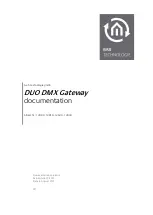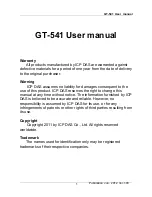
L-Proxy User Manual
57
LOYTEC
Version 3.1
LOYTEC electronics GmbH
2.
Integer to Integer conversion (I2I)
: This conversion type converts an integer value
(signed or unsigned) to another integer value (signed or unsigned) or vice versa. The
type of both values must be a SNVT with the same SI unit (e.g. SNVT_temp to
SNVT_temp_p).
3.
Enumeration conversion:
This type converts one enumeration value to another
enumeration value. If the value is outside the range of the target enumeration, the
value is set to the first value of the target enumeration, which typically is the “invalid”-
value.
4.
Structure conversion
: This type converts one or more structure values to one or more
other structure values (e.g. multiple SNVT_switch to a single SNVT_state).
6.2 Network Interfaces on the L-Proxy
The L-Proxy as a physical device has 5 network ports. Port 1 and port 2 are FT-10 ports,
port 3 through 5 are IP-852 ports. The FT-10 ports are physically available on terminals 1
through 6 (see Section 3.7) and can be connected to two separate FT-10 channels.
In the LNS database each L-Proxy port corresponds to a single device in the LNS database.
These devices can be part of the same database (same domain) or live in different databases
(different domains). Figure 55 shows an example in which all five ports of one physical
L-Proxy are represented as separate devices in the same LNS database.
The three IP-852 ports deserve more explanation. They are logical ports on the physical
Ethernet interface of the L-Proxy and connect to a single IP-852 channel. This means, that
the L-Proxy is added as a single CEA-852 device to the configuration server (see Section
4.3.6). In the LNS database they are treated as three separate devices, with three different
Node IDs. This means, that each of the IP-852 ports has to be added to an LNS database
separately. Figure 55 depicts this situation for Port 3 to 5.
Port 1
FT-10
Port 2
FT-10
Port 3
IP-852
Port 4
IP-852
Port 5
IP-852
FT-10
Channel 1
FT-10
Channel 2
IP-852
Channel
Figure 55: FT-10 and IP-852 ports on the L-Proxy
The IP-852 ports connected to the IP-852 backbone channel can be converted to more
FT-10 channels in combination with CEA-852 routers such as the L-IP. Figure 56 shows a
network diagram to illustrate this concept. Domains 2, 3, and 4 are attached via L-IPs to the
L-Proxy’s IP-852 ports.
Summary of Contents for L-Proxy
Page 1: ...L Proxy CEA 709 Gateway User Manual LOYTEC electronics GmbH ...
Page 10: ......















































